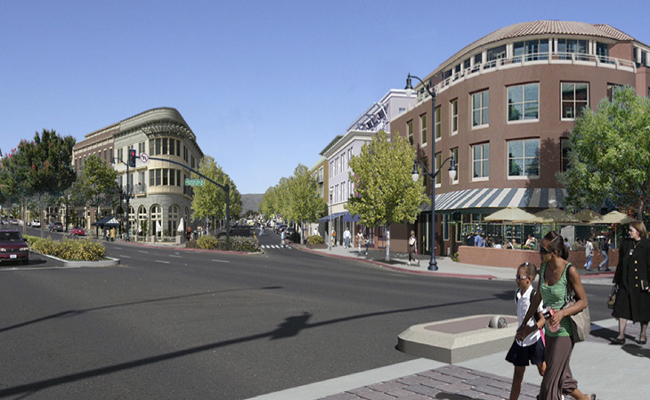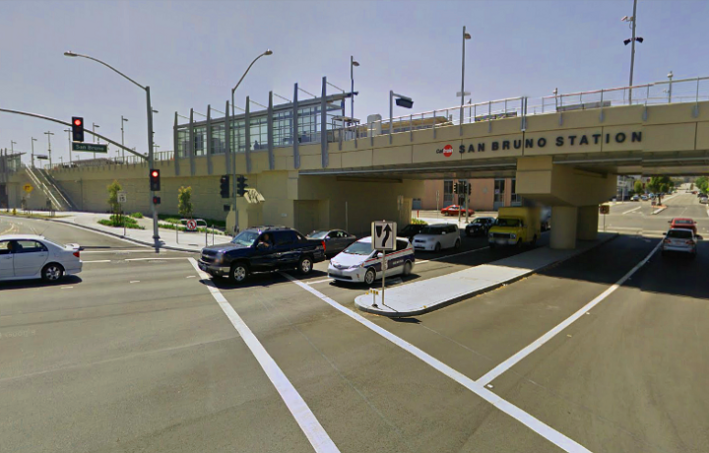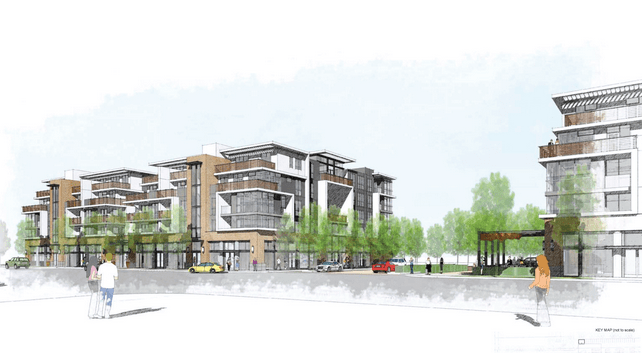Voters Back Downtown Growth in San Bruno and Menlo Park
5:23 PM PST on November 7, 2014

Tuesday's election saw large majorities of San Bruno and Menlo Park voters approve plans for substantial new downtown development. The plans could potentially transform both downtowns by bringing several thousand more workers and residents within walking distance of the two Peninsula cities' Caltrain stations, both improving transit ridership and making the downtowns livelier, more livable places.
San Bruno's Measure N, approved by 67 percent of voters, raises height limits for new buildings on the city's downtown commercial streets. Menlo Park's Measure M would have slowed growth by placing new restrictions and caps on future downtown development, but it was rejected by 62 percent of voters.
Both cities grew up with traditional downtowns centered around railroad stations, and both have a grid of pre-war streets centered on their Caltrain stations and El Camino Real, the Peninsula's historic main street and a major bus corridor. Neither San Bruno nor Menlo Park have attracted higher density, mixed-use development to their downtowns, unlike larger cities in San Mateo County like San Mateo or Redwood City.
"I believe our planners have done sound work to revitalize our downtown, and surrounding neighborhoods, as a vibrant mixed-use area with jobs, housing, new shops and beautiful public places in close proximity to our Caltrain station," said San Bruno Mayor Jim Ruane of the city's Transit Corridors Plan, which required Measure N's passage before it could be implemented, according to city officials. "We need housing, and we need it desperately," said Ruane.

Measure N repeals several provisions set forth in Ordinance 1284, a 1977 initiative which slowed commercial and residential development in San Bruno by requiring that voters approve plans for any building exceeding 50 feet (or three stories) in height. Voters have approved two such construction projects since then: the Tanforan indoor shopping mall in 1984, and The Crossing, an 835-unit, five-story residential development, in 2001.
In addition to raising maximum building heights from 50 feet to 90 feet adjacent to San Bruno's Caltrain station, 70 feet along El Camino Real, and 65 feet along San Bruno Avenue, Measure N also eliminates Ordinance 1284's ban on multi-story parking structures, and allows increased density on 42 residentially zoned parcels that are mostly along Mastick Avenue.
City planners estimate that the passage of Measure N will roughly double commercial and residential development over the next 20 years around San Bruno's new downtown Caltrain station and along El Camino Real, San Bruno Avenue, and San Mateo Avenue. The downtown area could then house roughly 4,000 new jobs and 3,800 new residents.
Menlo Park has somewhat fewer residents (32,000) than San Bruno (41,000), but the city is a major jobs center, with about two employees to every resident. As a result, Menlo Park's Caltrain station is the 9th busiest out of the 29 stations with regular weekday service, even though there haven't been any large office or housing projects in downtown in recent years.

Measure M, a voter initiative placed on Menlo Park's ballot after gathering nearly 2,400 signatures this spring, would have placed new caps on commercial development downtown, required voter approval for larger developments, and effectively stopped two major office-retail-housing developments planned for vacant lots along El Camino Real. Vastly larger, office-only projects located far from Menlo Park's transit-rich downtown are already under construction or have been approved, including Facebook's expansion (to up to 9,400 employees) at Bayfront Expressway and Willow Road.
In addition to rejecting the growth-limiting measure, voters in Menlo Park re-elected the city council's three incumbents, Peter Ohtaki, Kirsten Keith, and Richard Cline. All five members of the city council encouraged residents to vote against Measure M when it landed on the November 4 ballot. Kelly Fergusson, a council member from 2004 to 2012, helped lead the effort to place Measure M on the ballot, and was among the three challengers for a seat on the city council. Proponents of the Yes on M campaign backed her, and fellow challengers Drew Combs and Kristin Duriseti.
While the approval of San Bruno's Measure N by voters clears the way for more new office buildings, retail, and multi-family housing in the city's downtown, the city is still awaiting proposals from developers for what it envisions as "catalytic opportunity sites." These sites are expected to "stimulate development and synergize public improvements with private project opportunities," according to the Transit Corridors Plan. However, the two mixed-use developments along El Camino Real can now proceed to City Council for approval.
Menlo Park officials have insisted that Stanford University's office and housing proposal, on what were former car dealerships, also include funds for a pedestrian/bicycle tunnel under the Caltrain tracks at Middle Avenue, near the northern end of its site. Stanford representatives have previously stated that they prefer the tunnel to be funded using public grants, rather than as an impact fee to be paid by the university.
Stay in touch
Sign up for our free newsletter



